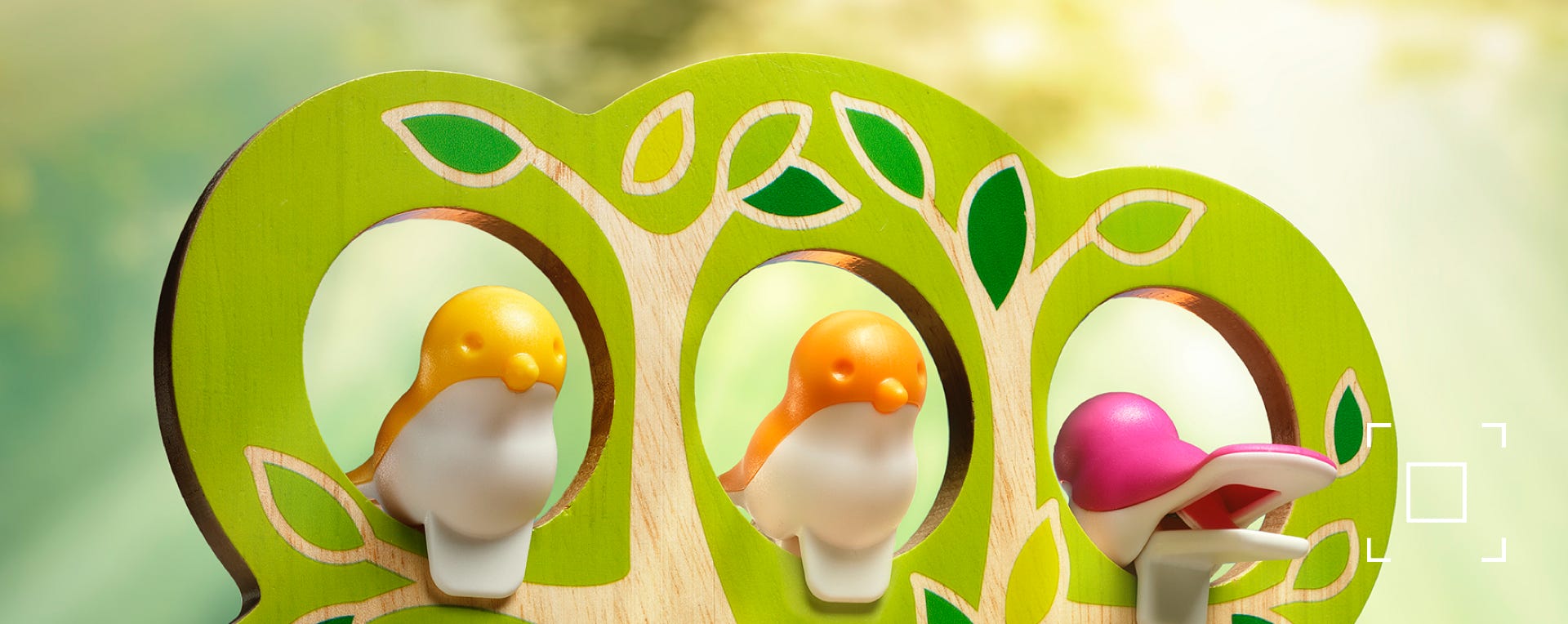
5 Little Birds
The product development of Five Little Birds (for SmartGames)
Raf Peeters, January 2024
5 Little Birds is a new wooden game I developed for SmartGames in 2023. The previous wooden puzzle I designed already dates back to 2016. The reason is simple: we struggled to create a high-quality wooden game that was also affordable. These days, most other wooden SmartGames on the market cost around 30 euros, which is (too) expensive for many customers. When I started this project, the goal was to make a product of 25 euro. One obvious way to achieve this was to use less wood. But to make sure that it still would be perceived as a “wooden game”, we used a sheet of rubberwood and placed it vertically. BTW, the theme for this game is a tree with birds, because what could better symbolize wood than a tree?
THE KEY FOR A GREAT PUZZLE GAME
The second source of inspiration came from my key chain. Years ago, we purchased four bird-themed keychains for each family member. These keychains came with four small white houses that hung in our hallway. The concept was simple: place your bird (with keys) in your designated house every time you enter, making it easy to see who is at home and eliminating the need to search for your keys. While it worked well initially, the metal rings at the bottom of the birds eventually broke. Now, we have four empty white houses serving no purpose. But the birds did look cute. They were very stylized, so they didn’t look too childish at all. When we were developing the birds for this game I asked my colleague Leighton to try something similar (but better of course). A big challenge was to find a good way to attach the birds to the tree. After experimenting with various clipping mechanisms, we settled on one that didn't involve a metal spring. Instead, we utilized a part of the plastic bottom, combined with the tail, to create a flexible clip. This clip is robust enough to secure the birds anywhere on the tree but gentle enough to avoid causing harm if fingers are pinced. We use a metal axis so that both parts of the bird can hinge, but this metal parts is completely hidden inside the bird and not accessible. This makes the birds completely safe and also looks so much better. Because the birds already needed to be made from different parts anyway, we decided to make the top part in a bright color and the bottom parts in white. While my colleague Hans initially created a few options for the artwork of the tree, I refined and simplified it to match the simplicity of the birds. In the initial prototypes, the tree's foot was also made of wood, but it proved too fragile during safety testing. The "drop testing" revealed that the weight of the fully assembled tree could cause this small wooden part to break. Consequently, we replaced the wooden foot with an ABS plastic one. This actually looks better, because the shape of the circular base matches one of the most visual properties of the tree: the 7 holes. And it also works better, because during play you often need to rotate the tree, which is much easier with a circular base.
Now you know a lot of details about the game’s looks, but I haven’t explained anything about the game play yet. Although I designed more than 130 SmartGames so far, I basically use the same 5 game mechanics again and again:
• Matching games (e.g., Bunny Boo and Castle Logix): match a given image
• Rule based logic games: fit everything on a game board according to hints given in the challenge
• Packing problems (e.g., all IQ-puzzles, SmartCar 5x5 and Trucky 3): fit all puzzle pieces on a 2D or 3D grid
• Connection games (e.g., example Camelot JR and Little Red Riding Hood): make a connection between 2 or more points.
• Sequential movement puzzels (e.g., Safari Park JR and Squirrels Go Nuts): move pieces to a goal.
I don’t like to repeat myself, so of course I try to do something different with the same game concepts every time I use it. At the beginning of each year, I analyse my previous work. Last year I realized that, so far, I haven't developed many "pure" logic games; Snowwhite Deluxe is one of the exceptions. The key distinction between a packing problem and a logic puzzle lies in the constraints. In a packing problem, the shape of the pieces and the game board dictate this. If everything fits you also know that you found the solution. In contrast, a logic puzzle's constraints are solely defined by the rules or hints in the challenges. Each piece can fit anywhere physically, so you still need to check your solution to know if your solution is correct or not. This is the primary reason I don't frequently use this game mechanic, as I prefer puzzle games that don't demand such effort from players. However, in this case, it's relatively simple, given that there are only five birds in the game. Originally there was also a figurine of a cat, but we later removed it again. It look weird, because it was either too large for the tree or too small compared to the birds. And it didn’t make the challenges harder or more interesting either.
HEAD OR TAIL?
The objective is to place the birds in the right positions on the tree based on hints regarding color, orientation and relative position of other birds in the tree. The hints also specify which tree holes must remain empty. There are 7 holes and only 5 birds, so 2 holes will never contain a bird. What sets this game apart from many similar logic games, such as Chocolate Fix by ThinkFun or Diamond Quest by SmartGames, is that hints can reveal either the front or backside of the tree. Challenges often present a combination of hints from the front and back. Easier challenges display almost the entire tree and are already suitable for 4- to 5-year-old kids. But the hardest challenges show a lot of different, small hints that need to be combined to find the solution. In the hardest level some birds in the challenge don’t show a color, but only an orientation. As a result, many of the 80 challenges are interesting enough for teens and adults as well, making it the only 5+ game with a Wizard level. That’s also the reason why this game is not marketed as a preschool game. Some of these challenges proved too challenging even for me during play testing. I usually give up after 10 minutes, not due to a lack of perseverance but a lack of time. I find it important to test every challenge myself and if you are developing so many games like I did the last few years, this means that more than a thousand challenges need to be solved. Anyway, if a challenge can’t be solved in less than 10 minutes, I already know it’s going to be hard one for most people. There used to be a time that most SmartGames only had 4 levels of difficulty. Sometimes people complained that they wanted more challenges after they solved everything. Since we included this fifth “Wizard” level we don’t get these complaints anymore. Because most “normal” people never solve these hardest challenges. I can’t, so don’t feel bad if you can’t either.
To ensure that each set of hints resulted in a challenge with a unique solution, my new colleague Yorick from IT developed a program with a user-friendly interface for testing. Without his assistance, my work would have been significantly more challenging and time-consuming. And although I didn't use the tree print designs that Hans created, I love the illustration he made for the frontside of the packaging. 5 Little Birds will be available in Spring 2024.
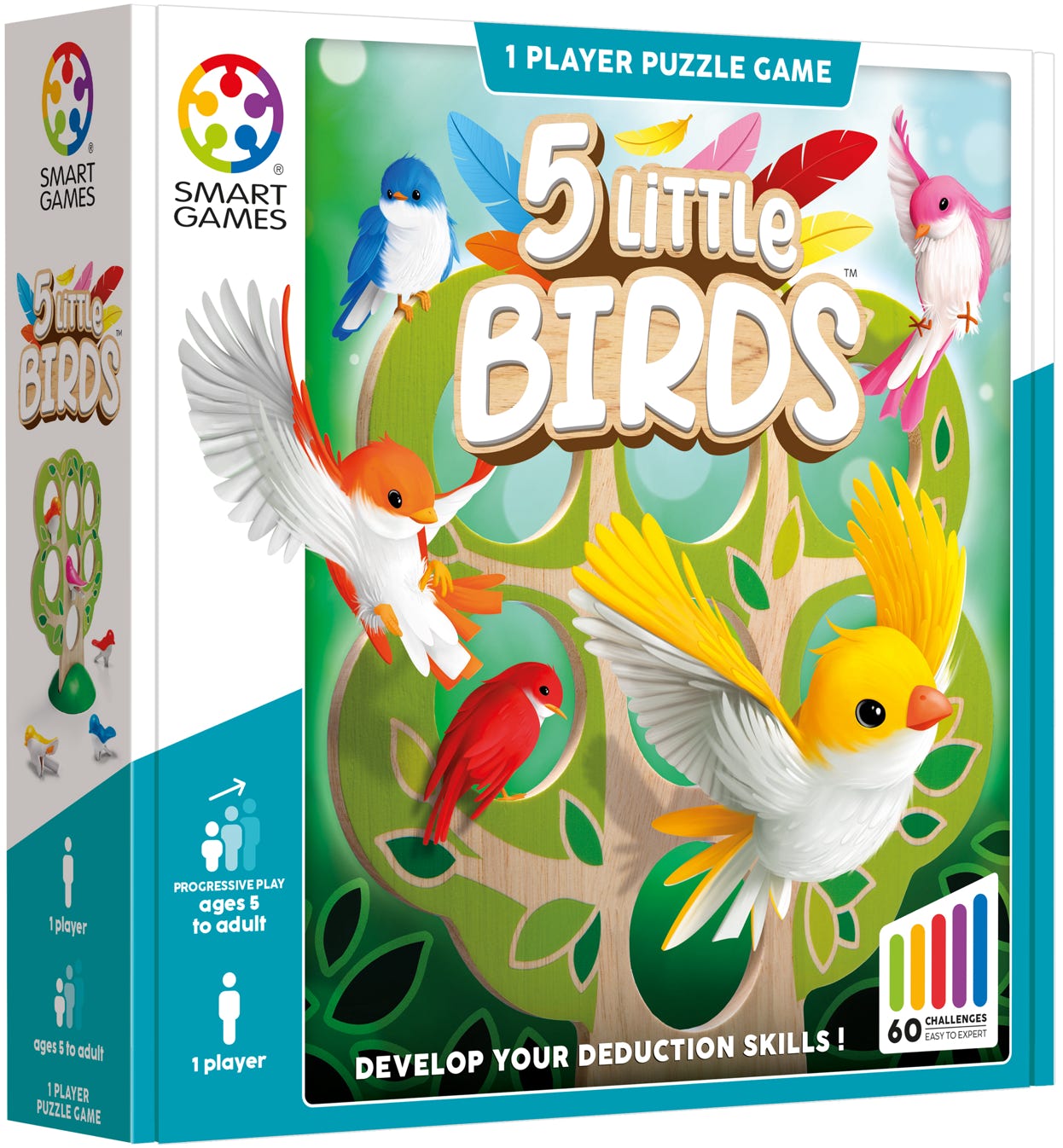
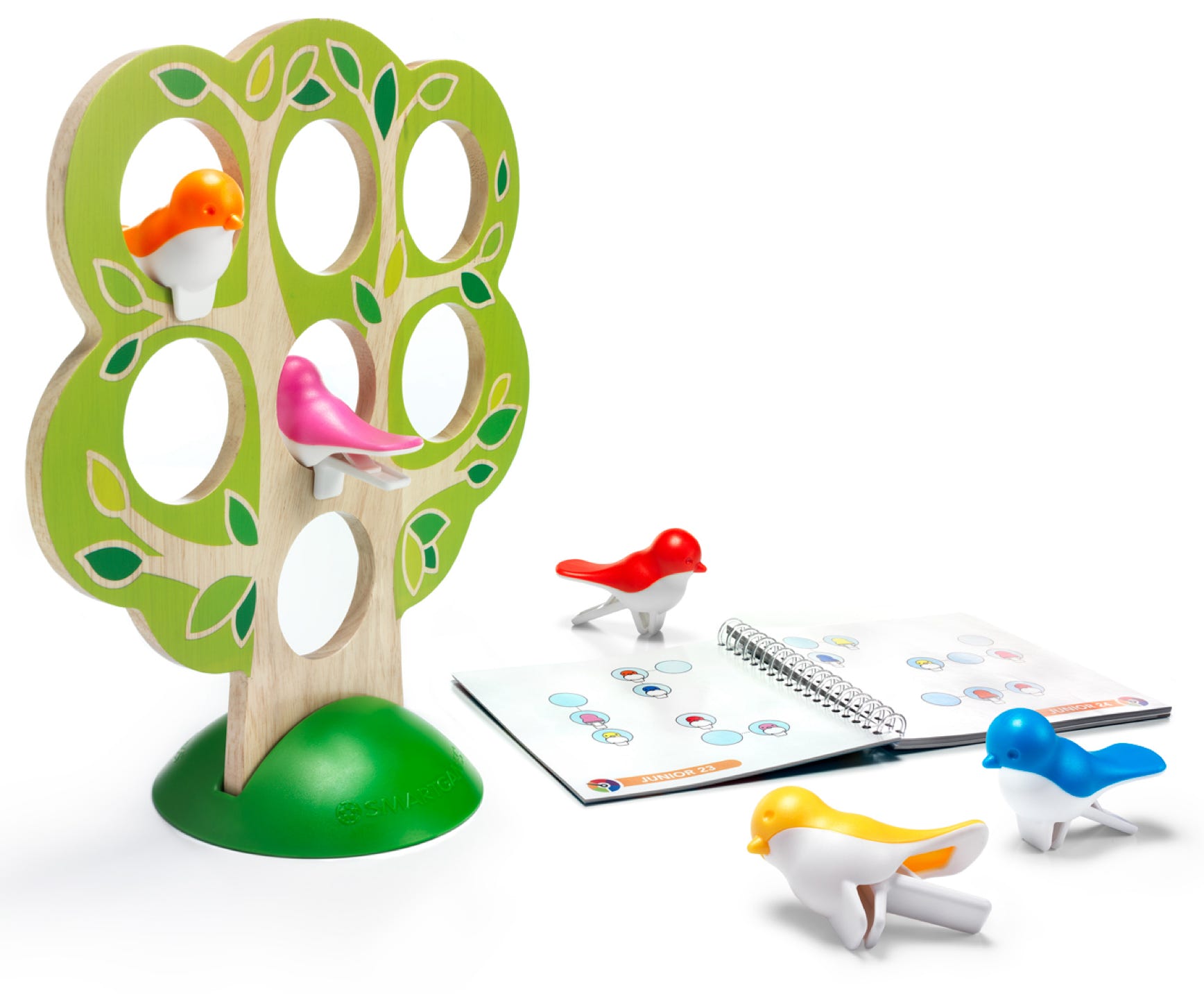
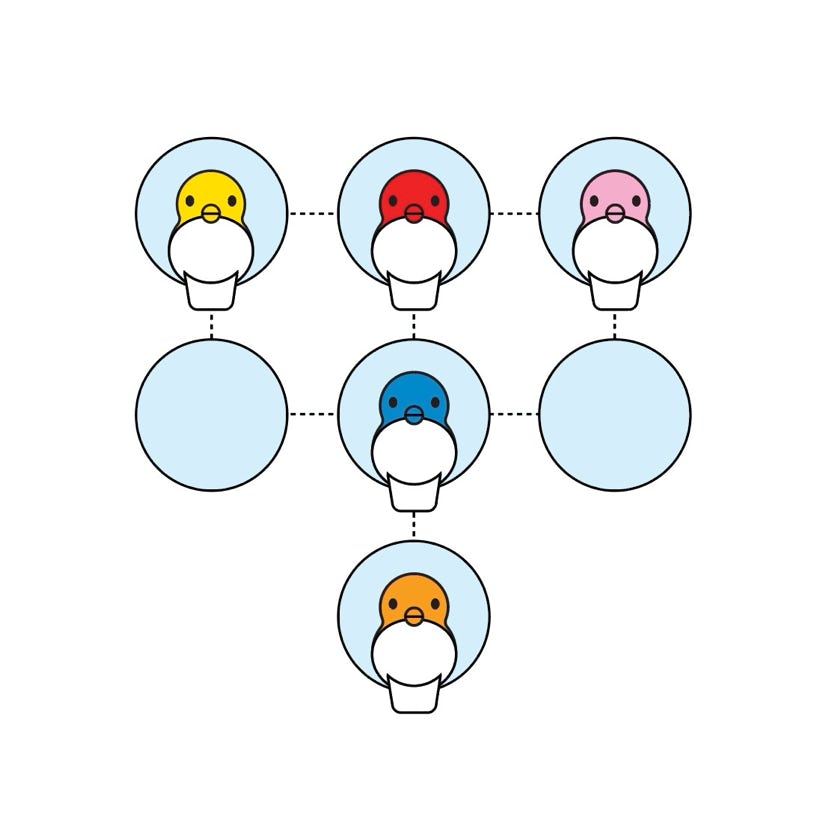
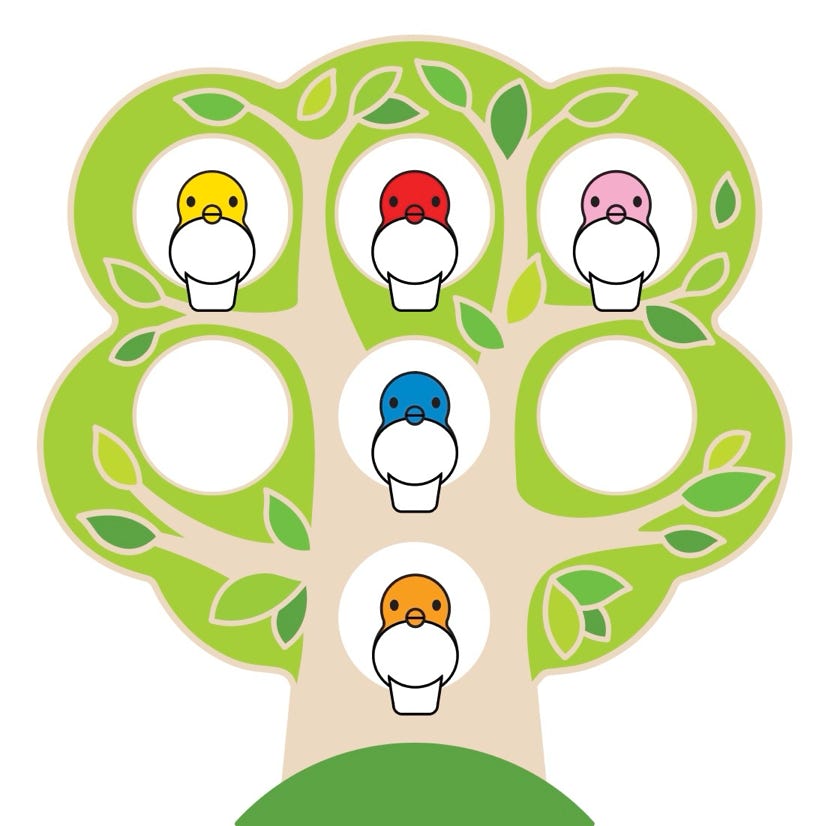
Example of a STARTER challenge (left) and solution (right)
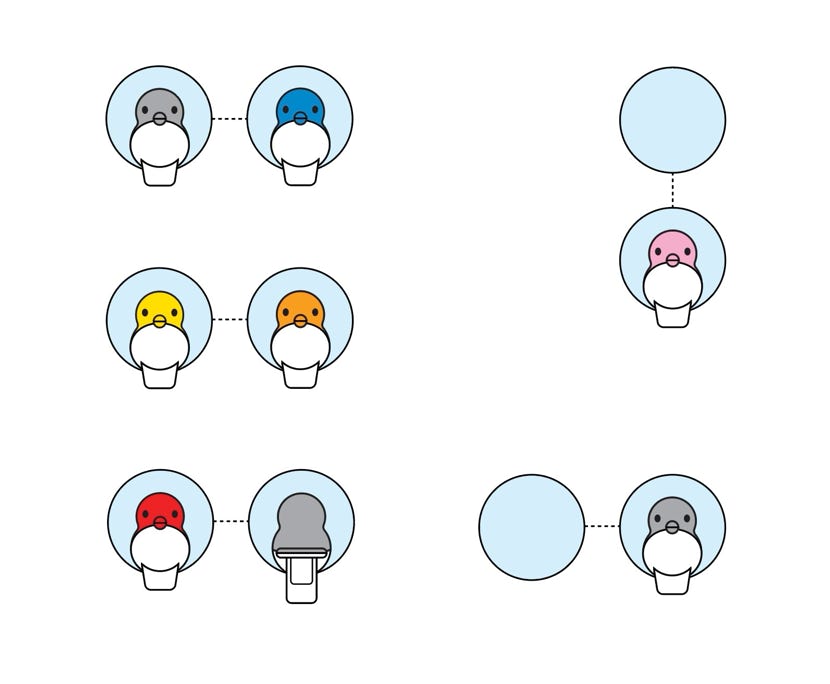
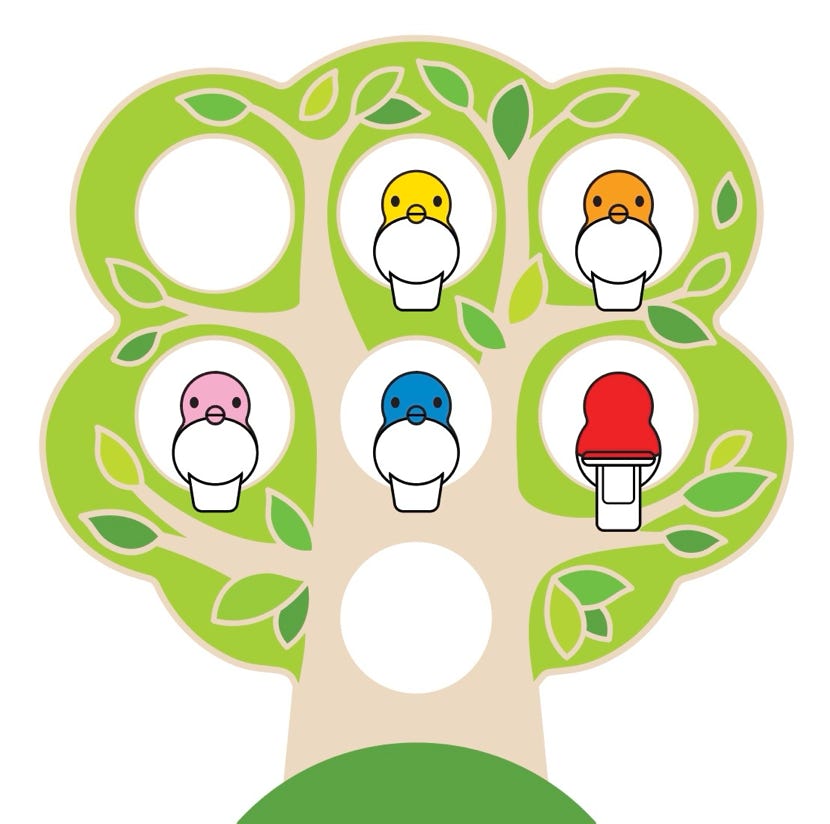
Example of a Wizard challenge (left) and solution (right)
GAME RULES 5 LITTLE BIRDS
Before you start: Insert the wooden tree inside the base. Remove all the birds from the tree.
1) Choose a challenge. Challenges show hints about the final position of each of the 5 birds inside the tree:
A) A hint can show the relative position of the birds on the front OR the back of the tree.
B) A hint can also show the position of an empty hole. This hole MUST stay empty in the solution. There are 7 holes and only 5 birds, so 2 holes will always stay empty in the solution.
C) A yellow/orange/red/pink/blue bird indicates that the bird with that colour should be placed there. It can either show the frontside or backside of the bird. The orientation of the bird is relevant for the solution.
D) In more advanced challenges some hints will only reveal the orientation of a bird, but not its colour. In these cases, the bird is depicted in grey.
E) Hints may also show the colour and/or orientation of other birds in holes nearby. Only holes that are connected by a dotted line or by the tail of birds are part of the same hint. A challenge might show multiple separate hints, where each hint reveals different information about the relative position of the birds.
F) Sometimes a challenge will show a mix of frontside and backside hints. You don't know which side of the tree is shown in a hint until you find the solution.
2) Place all birds inside the tree, so that their position matches all the information given in the hints.
3) There is only 1 solution for each challenge shown at the back of the challenge booklet. Solutions show the tree with the position and orientation of the 5 birds. Since both sides of the tree look identical, the solution will show the side of the tree that has the most birds in front view.
Hints for parents and teachers:
Please remove all birds from the tree if you are not planning to play for a long time. This will ensure the clipping mechanism works optimally inside the birds. This game can be challenging for children who are new to logic games. Encourage them to find the solution themselves by asking guiding questions, such as:
- Where do you think you need to put the red bird and why?
- Does this hint help you with the yellow bird? What does it help you with?
Website ©2024 Raf Peeters
Products and images: © Smart
